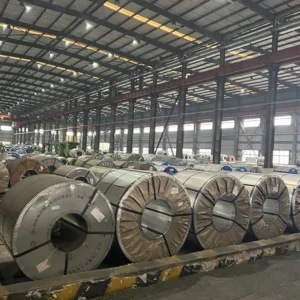Introduction
As global industries strive to improve energy efficiency and meet rigorous environmental standards, the demand for advanced materials like cold rolled electrical steel continues to grow. Widely used in transformers, electric motors, and power generators, this specialized steel plays a vital role in minimizing energy losses and enhancing the performance of electrical devices.
This article delves into the key properties, production methods, applications, and market relevance of cold rolled electrical steel, especially in the context of Europe and the Middle East—regions known for their focus on technological innovation and energy sustainability.
What Is Cold Rolled Electrical Steel?
Cold rolled electrical steel is a type of silicon steel engineered specifically for electromagnetic applications. It is produced by cold rolling steel to achieve precise dimensions, followed by a series of heat treatments and coatings to optimize its magnetic properties.
Two main variants exist:
- Grain-Oriented (GO) Cold Rolled Electrical Steel: Used in transformers where magnetic fields flow in a single direction.
- Non-Grain-Oriented (NGO) Cold Rolled Electrical Steel: Applied in motors and generators with rotating magnetic fields.
Both types are designed to reduce core loss, improve magnetic permeability, and provide thermal and mechanical stability—crucial for devices that operate continuously under high stress or load.
The Manufacturing Process
Producing cold rolled electrical steel involves a multi-step process that ensures tight control over the steel’s microstructure and surface condition:
- Hot Rolling: The initial steel slab is rolled at high temperatures to reduce thickness.
- Pickling: The surface oxide layer is removed using acid treatment.
- Cold Rolling: This step further reduces thickness and enhances surface smoothness.
- Annealing: A heat treatment that optimizes grain orientation and magnetic properties.
- Decarburization: Removes excess carbon to minimize magnetic loss.
- Coating: An insulating layer is applied to reduce eddy current losses and prevent corrosion.
Each step is engineered to meet strict standards for flatness, thickness tolerance, and magnetic performance.
Key Properties and Advantages
- Low Core Loss: Essential for reducing power consumption in magnetic circuits.
- High Magnetic Permeability: Enables efficient magnetic flux conduction.
- Uniform Thickness and Surface Finish: Critical for producing high-performance electrical components.
- Excellent Insulating Coating: Reduces eddy current losses and improves thermal stability.
- Mechanical Strength and Flexibility: Suitable for precision cutting and shaping.
These advantages translate into better-performing transformers, motors, and generators, helping reduce operational costs and environmental impact.
Applications of Cold Rolled Electrical Steel
1. Power Transformers
In power distribution systems, grain-oriented cold rolled electrical steel is used to manufacture transformer cores. These cores require materials that guide magnetic fields with minimal resistance, ensuring efficient energy transfer across long distances.
2. Electric Motors
Non-grain-oriented variants are ideal for use in motors across automotive, industrial, and commercial applications. The steel’s ability to withstand high speeds and temperatures while maintaining magnetic efficiency makes it indispensable in electric vehicle motors and HVAC systems.
3. Generators and Alternators
For both renewable and conventional power generation, cold rolled electrical steel enhances output and efficiency, especially in high-frequency and high-capacity systems.
4. Appliances and Electronics
Energy-efficient home appliances, from washing machines to refrigerators, use compact motors built with cold rolled electrical steel to meet energy rating standards in Europe and the Middle East.
5. Renewable Energy Systems
In wind turbines and solar inverters, this steel helps reduce energy loss and ensures stable operation under variable conditions.
Market Demand in Europe and the Middle East
In Europe, strict regulatory frameworks like the Ecodesign Directive and the Green Deal have pushed manufacturers to adopt more energy-efficient materials. Cold rolled electrical steel is a key component in meeting efficiency targets and reducing CO₂ emissions in electrical equipment.
In the Middle East, governments are investing in modern power infrastructure, renewable energy projects, and electrified transport systems. This transition increases demand for high-performance electrical materials that support long-term sustainability and reduce dependency on fossil fuels.
Technological Advancements
- Laser Scribing: Used on grain-oriented steel to refine magnetic domains, further reducing core loss.
- High-Frequency Grades: Developed for inverters and fast-rotating motors used in modern applications.
- Thin Gauge Steel: As thin as 0.18 mm for applications requiring compact design and high efficiency.
- Eco-Friendly Coatings: Advanced insulation layers that enhance performance and meet environmental standards.
These innovations ensure that cold rolled electrical steel continues to evolve in line with the demands of future technologies.
Environmental and Economic Benefits
The efficiency improvements gained through the use of cold rolled electrical steel contribute significantly to energy savings. For example:
- Reducing transformer core loss by 10–20% leads to substantial cost savings over time.
- In EV motors, enhanced magnetic performance extends driving range and reduces battery strain.
- Lowered energy consumption translates to fewer CO₂ emissions, supporting climate goals.
Moreover, this steel is recyclable, and its manufacturing process is continually being optimized to reduce waste and energy input.
Challenges and Outlook
Despite its benefits, the production of cold rolled electrical steel faces certain challenges:
- Material Costs: Silicon and energy-intensive production processes raise overall cost.
- Supply Chain Issues: Regional shortages or import tariffs can impact availability.
- Technical Complexity: Requires advanced equipment and strict quality control.
However, increased investment in local production facilities in Europe and the Middle East is helping to mitigate these issues. Strategic partnerships and digital manufacturing technologies are expected to drive growth in the coming decade.
Conclusion
Cold rolled electrical steel is a foundational material in modern electrical engineering. Its ability to reduce energy loss, enhance magnetic performance, and support sustainable development makes it an essential component in power systems, industrial machinery, and consumer electronics.
As both Europe and the Middle East accelerate their transition toward energy efficiency and renewable technologies, the role of cold rolled electrical steel will only become more prominent. Businesses that integrate this high-performance material into their products will be well-positioned to meet the demands of a smarter, cleaner future.
Would you like this blog formatted for WordPress, exported as a PDF/Word document, or adapted into a shorter LinkedIn post?
询问 ChatGPT




